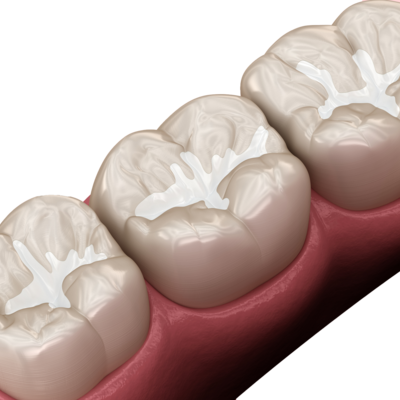
Dental sealants are a preventive treatment option commonly performed on children and adults all over the world.
Dental sealants provide many oral health benefits. Understanding preventative care procedures and how they protect our teeth will help you make informed decisions for your family’s oral health.
A dental sealant is a thin, protective coating applied to the chewing surfaces of our teeth. The material of a sealant has an adhesive that bonds with tooth enamel, to fill in the deep pits and grooves that commonly catch food. This is the most common place to get a cavity.
A sealant changes the chewing surface so that there are no longer deep crevices to collect dental plaque. By filling in those pits and grooves and preventing plaque accumulation, a sealant prevents cavities before they start! The smooth surface a sealant creates repels plaque and food debris and makes our teeth easier to clean.
Anyone with teeth is a good candidate for sealants. Sealants can protect teeth from cavities for many years. There are several categories of people who may receive added benefits from sealants.
Children
Young children’s permanent molars begin erupting into their mouths around age six. At this time, most children are not adept at manipulating a toothbrush to properly clean away all of the dental plaque on their teeth. By placing dental sealants on the molars, we can create a surface that is easier to clean for a young child.
Dental insurance companies support the use of sealants and tend to cover them at 100% for children up to a certain age.
Special Needs Patients
Patients with special mental or physical challenges can also benefit from sealants. Whether a mental challenge makes consistent oral hygiene hard to manage, or a physical challenge makes performing the tasks of brushing and flossing difficult, dental sealants can protect the teeth from cavities on the biting surfaces.
Adults with High Risk Teeth
The anatomy of teeth varies widely. Some people have teeth with extraordinarily deep pits and grooves that are almost guaranteed to suffer decay at some point. Your dentist can identify these high-risk areas and recommend a sealant to prevent that decay.
For example, grooves with dark stains that have not yet decayed are likely to deteriorate at some point. A groove or pit that collects stain is also collecting bacteria. You can prevent that bacteria from causing a cavity by sealing it.

First, your dentist or hygienist will isolate the tooth to receive the sealant by cleaning it and placing cotton around it. Saliva will interfere with the sealant’s adhesion to the tooth. After isolation, an etchant is applied to clean the tooth surface, preparing it for the bonded sealant material. After the etchant is rinsed away, a tiny paintbrush is used to fill in the grooves and pits of your tooth with the runny sealant material. Once the sealant material is in the correct place, the dentist “cures” the material by shining a bright blue light on it. This light causes a reaction that makes the material harden.
Patients may notice a bitter taste which can easily be rinsed away. After a sealant’s initial placement it may feel like there is something stuck in between the teeth. Don’t worry, this feeling is temporary, lasting only a few days at the most.
Sealants can last on the teeth for many years! However, there are a few habits or activities that can shorten a sealant’s lifespan. These include:
If you notice that a sealant has come off of your tooth, simply call your dentist and schedule a visit for replacement. Your dentist can replace the sealant quickly and easily. If your dentist determines that the risk of decay is no longer high on this tooth, you may not need a replacement. This is best determined on a case-by-case basis, as everyone has a different level of risk for decay.
Prevention of a dental problem is always less expensive and less uncomfortable than treatment to repair a future problem. Dental sealants are one of the most powerful ways to prevent cavities, and have become an essential part of our dental care.
In order to know if you or your children need sealants, schedule an evaluation with us today. Taking steps now to prevent cavities saves you time and money in the future!
Mon – Thu: 7am – 4pm
Fri: By Appointment Only
Sat – Sun: CLOSED
Meyerwood Dentistry © 2025 | All Rights Reserved